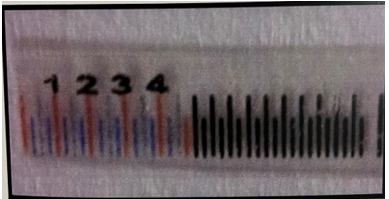A Study on Clinical Comparison Between Expasyl Retraction System and Medicated Retraction Cord on Gingival Retraction.
Main Article Content
Abstract
Aim: This study is done to evaluate clinical efficacy of Expasyl and medicated retraction in subgingivally prepared teeth. This is done by evaluating vertical displacement of gingiva. Method: In the present study, total 30 subjects were selected. Clinical efficacy of Expasyl retraction system and medicated cord retraction system were studied for adequate vertical gingival displacement by direct assessment of the sulcus dilation on the prepared teeth with help of flexible measuring strip pre and post retraction, which includes paired abutments of any one segment of either maxillary or mandibular arch. Statistical analysis was done to compare two systems.
Result: Expasyl retraction technique was more effective in vertical gingival retraction (mean- 0.32 mm) than medicated retraction cord technique (mean-0.30mm) with a t value at 1.175 and P - value of 0.25 mm. conclusion: The amount of vertical gingival retraction obtained by Expasyl and medicated cord was significantly similar but Expasyl retraction system is not cost effective when compared with cord system.
Article Details
References
Shah DS, Vaishnav K, Duseja S, Joshi R. Clinical Evaluation Of Fixed Dental Prosthesis Failures In Indian Population : An In Vivo Study. Adv Hum Biol. 2014;4(3):37-43.
Rosensteil SF, Land MF, Fujimoto J.Contemporary Fixed Prosthodontics. 3rd edition St. Louis; Mosby Inc. 2001:354
Shillingburg HT, Hobo S, Whitsett LD. Fundamentals of fixed prosthodontics, 3rd ed. Chicago: Quintessence publishing co.; 1997
Tylman SD. Theory and practice of crown and partial fixed prosthodontics, 8th ed. St.Louis: The C.V. Mosby Co. 22
Nixon KC, Adkins KF. Histological effects produced in alveolar bone following gingival incision with an electro-surgical scalpel. J Periodontol 1975; 46; 40-4.
Newman, Takei, Carranza. Clinical periodontology, 9th edition sounders. 2003.p 949
Benson BW, Bomberg TJ, Hatch RA, Hoffman W Jr.Tissue displacement methods in fixed prosthodontics. J Prosthet Dent 1986; 55:175-81.
Weir DJ, Williams BH. Clinical effectiveness of mechanical chemical tissue displacement methods. J Prosthet Dent 1984;51:326 9
La Forgia A. Cordless tissue retraction for impressions for fixed prosthesis. J Prosthet Dent 1967 ;17(4):379-386
Csempesz F, Vag J and Fazekas A. In vitro kinetic study of absorbency of retraction cords. J Prosthet Dent 2003;9(1):45-49
Kamansky FW, Tempel TR, Post AC. Gingival tissue response to rotary curettage. J Prosthet Dent 1984; 52:380-3.
Kellam SA, Smith JR, Scheffel SJ. Epinephrine absorption from commercial gingival retraction cords in clinical patients. J Prosthet Dent 1992; 68:761-5.
Hansen PA, Tira DE, Barlow J. Current methods of finish-line exposure by practicing prosthodontists. J Prosthod 1999; 8:163-70
Pelner RB, Kempler D, Stark MM, Lum LB, Nicholson RJ, Soelberg KB. Human blood pressure and pulse rate to the recemic epinephrine retraction cord. J Prosthet Dent 1978;39:287
Azzi R, Taso TF, Carranza FA and Kenney EB. Comparative study of gingival retraction methods. J Prosthet Dent 1983;50:561
Ramadan FA, BI-Sadeek M, Hassanein ES. Histopathologic response of gingival tissues to hemodent and aluminum chloride solutions as tissue displacement materials. Egypt Dent J 1972; 18:337-52.
Mokbel AM, Mohammed YR. Local effect of applying aluminum chloride on the dento-gingival unit as a tissue displacement material: part I. Egypt Dent J 1973; 19:35-48.
Burrell KH, Glick M. Hemostatics, astringents and gingival retraction cords. In: Ciancio SG, ed. ADA guide to dental therapeutics. 2nd ed. Chicago: American Dental Association; 2000:104-18.
Runyan DA, Reddy TG Jr., Shimoda LM. Fluid absorbency of retraction cords after soaking in aluminum chloride solution. J Prosthet Dent 1988; 60:676 8.
Cloyd S, Puri S. Using the double-cord packing technique of tissue retraction for making crown impressions. Dent Today 1999; 18:54-9
Shaw DH, Krejci RF. Gingival retraction preference of dentists in general practice. Quintessence Int 1986; 17:277-80.
Nemetz H, Donovan TE, Landesman H. Exposing the gingival margin: a systemic approach for the control of hemorrhage. J Prosthet Dent 1984; 51:647
De Gennaro, Landesman GC, et al. A comparison of gingival inflammation related to retraction cords. Journal of Prosthetic Dentistry 1982; 47,384-389
Feng, J., Aboyoussef, H, et al.The effect of gingival retraction procedures on periodontal indices and crevicular fluid cytokine levels: a pilot study.Journal of Prosthodontics 2006; 15, 108-112.
Ruel J, Schuessler PJ, Malament K, Mori D. Effect of retraction procedures on the periodontium in humans. J Prosthet Dent 1980; 44:508-15.
Yang JC, Tsai CM, M.S, et al. Injection-type gingival retraction material. Chin Dent J, 2005; 24(3): 147-151.

